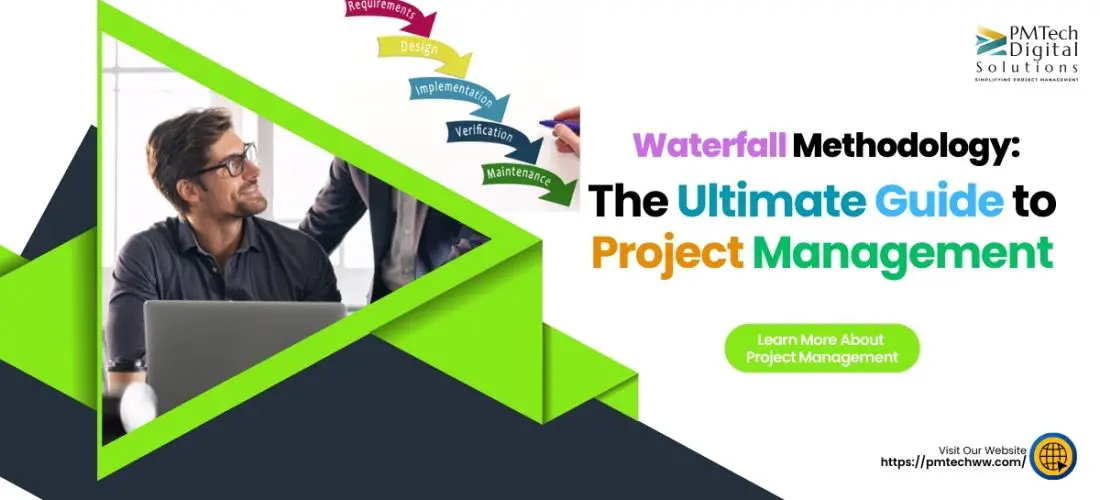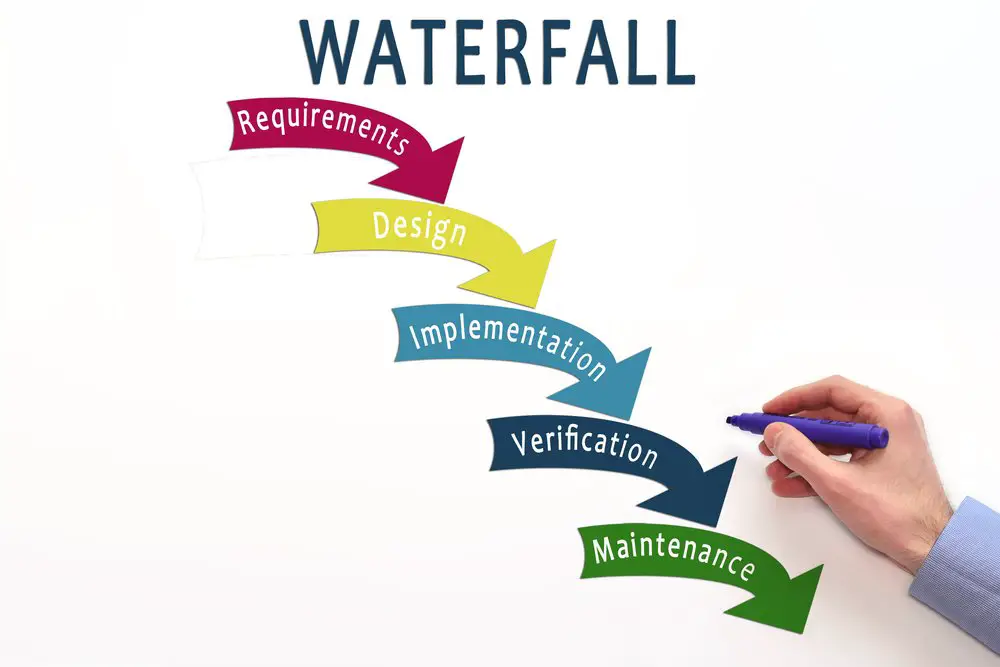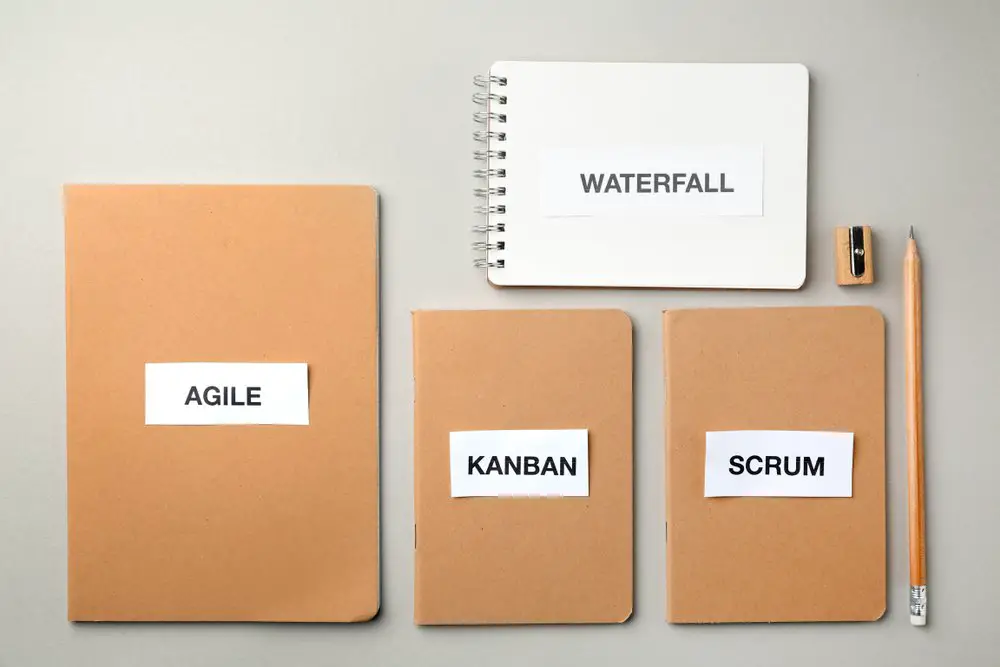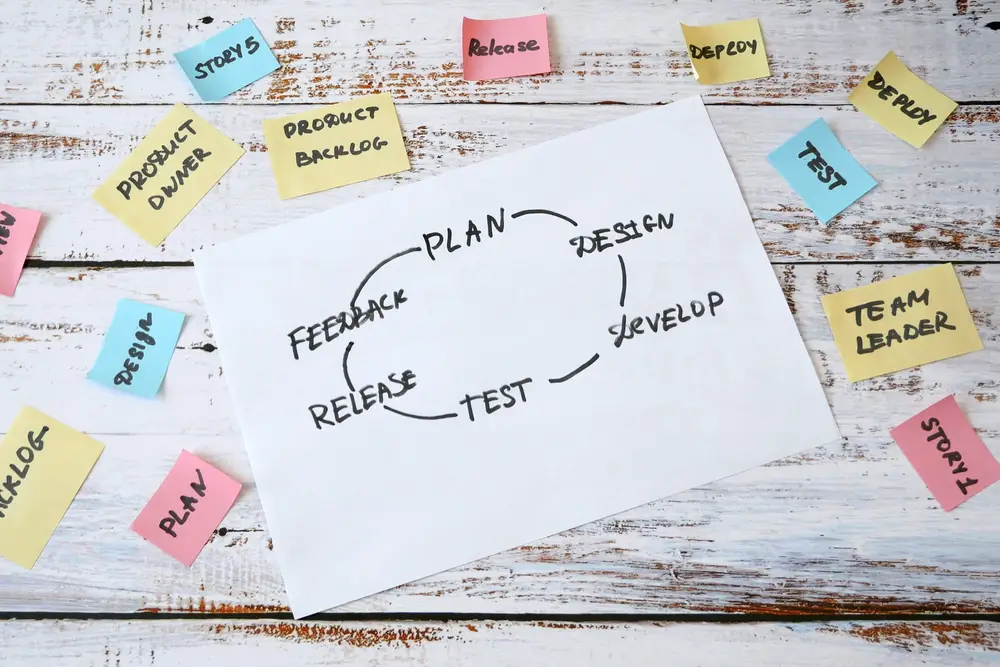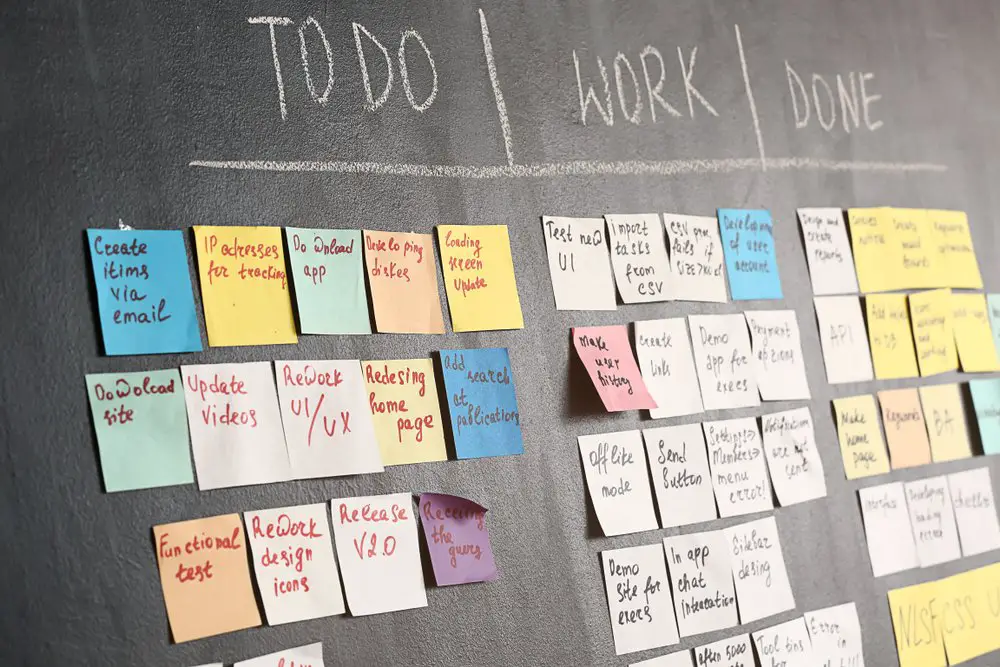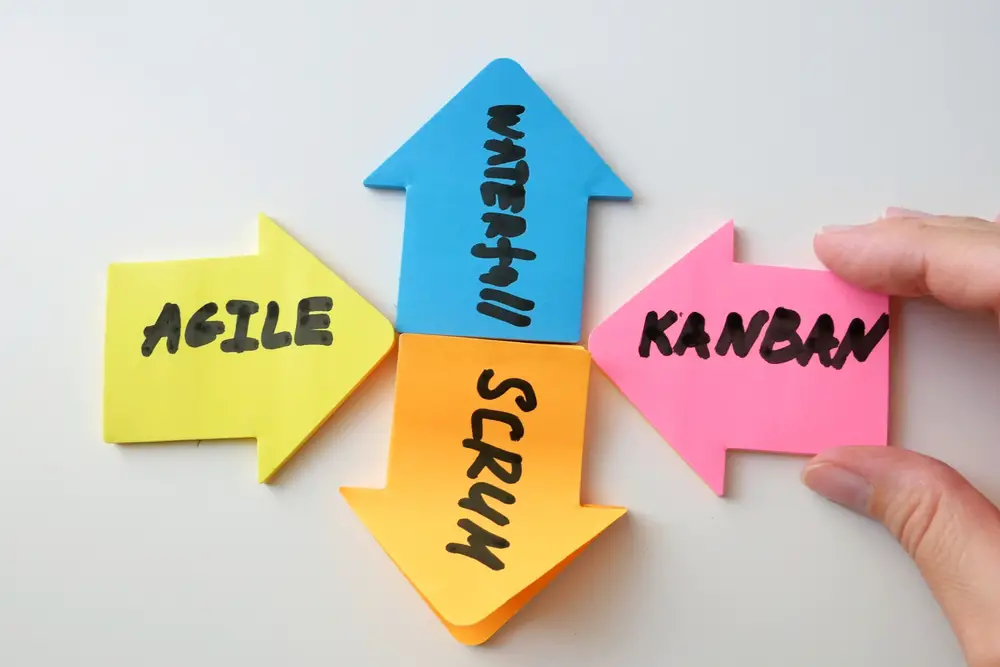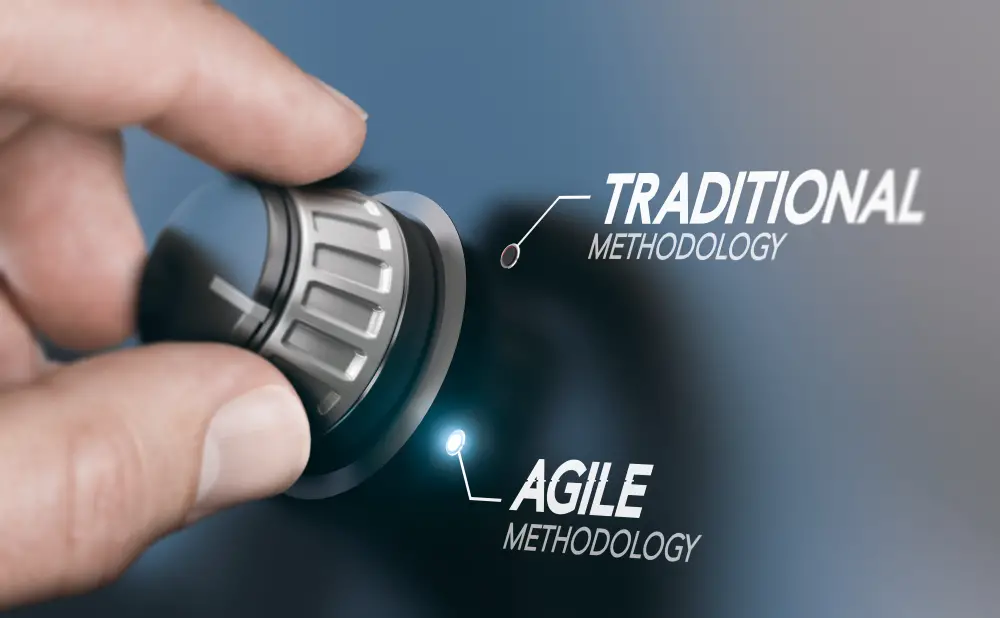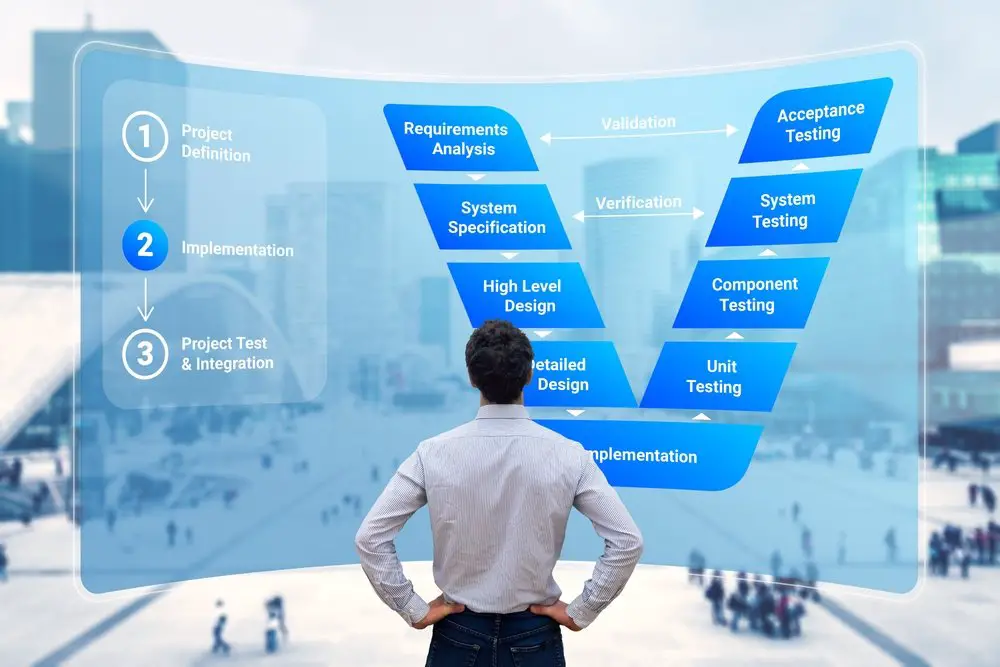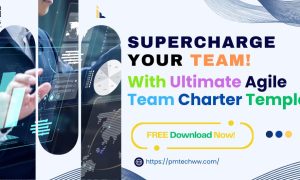The waterfall methodology has been a cornerstone in software development for decades. It involves a rigid process of sequential phases, each building upon the previous one’s completion. This traditional approach provides a clear structure for project teams to follow.
From requirements gathering to system design, implementation, testing, and final deployment, waterfall offers a structured path. It remains popular due to its comprehensive documentation and predictable timelines.
A PMI survey reveals that 37% of companies still rely on waterfall project management. Meanwhile, 41% have adopted either agile or a hybrid approach combining both methodologies. Waterfall’s staying power stems from its ability to manage projects with well-defined requirements.
This guide explores the fundamentals, advantages, challenges, and best practices of waterfall project management. Understanding this methodology is crucial for delivering successful projects in today’s competitive landscape.
Key Takeaways
- Waterfall methodology is a linear, sequential approach to project management
- It consists of five main phases: requirements gathering, design, implementation, testing, and deployment
- Waterfall is best suited for projects with well-defined requirements and fixed scope
- Advantages include clear structure, predictable timelines, and comprehensive documentation
- Challenges involve limited flexibility, difficulty gauging progress, and risks in phase integration
Understanding the Fundamentals of Waterfall Methodology
The waterfall methodology, introduced by Dr. Winston W. Royce in 1970, is a linear project management approach. It follows distinct phases: conception, initiation, analysis, design, construction, testing, implementation, and maintenance. Each phase must be completed before moving to the next.
Waterfall methodology relies heavily on thorough project planning and documentation. This approach aims to minimize risks by investing time in early stages. It focuses on gathering requirements, designing systems, and planning implementation. Such extensive planning aligns with traditional project management practices.
Stakeholders can easily estimate progress due to the structured nature of this methodology. The fixed outcome approach provides a clear roadmap for project teams to follow.
“The waterfall model requires documentation at every step, making it easy to repeat processes and train new team members.”
Waterfall methodology offers a simple, structured method for understanding and arranging tasks. However, it has limitations. The linear approach leaves little room for incorporating mid-process feedback from users or clients.
Design flaws often lead to starting over from scratch. Testing is delayed until the end of development. Projects using waterfall may not produce a working product until later stages.
| Advantages | Disadvantages |
|---|---|
| Clear structure and defined objectives | Limited flexibility for changes or innovation |
| Predictable timelines and budgets | Delays testing until the end of development |
| Comprehensive documentation | Not ideal for complex and high-risk projects |
Despite challenges, waterfall methodology remains popular for projects with well-defined requirements and minimal expected changes. Its sequential steps and emphasis on documentation benefit large or changing teams. This approach ensures disciplined and structured organization throughout the project lifecycle.
The Phases of Waterfall Project Management
Waterfall methodology follows a sequential flow in project management. Each phase builds upon the previous one. This structured process ensures organized progression and thorough documentation. It also allows for testing and validation of deliverables against requirements.
Requirements Gathering & Analysis
The first phase focuses on gathering and analyzing project requirements. This crucial step defines the project’s scope and identifies necessary resources. It also assigns team member responsibilities and creates a detailed timeline.
Understanding the project’s objectives and constraints is vital. It lays a solid foundation for the subsequent phases.
System Design & Planning
Once requirements are established, the design phase begins. Designers develop solutions that meet project specifications. They create schedules, set milestones, and determine exact deliverables.
This phase aligns the team’s efforts and keeps the project on track. Detailed documentation, like design specifications and project plans, is a hallmark of waterfall methodology.
Implementation & Coding
With the design in place, implementation begins. This stage involves creating a plan, collecting necessary data, and assigning tasks among the team. Developers work diligently to bring the project to life, following established design and requirements.
Regular progress tracking and risk management are inherent in waterfall methodology. This allows for identification and mitigation of potential issues.
Testing & Quality Assurance
As the project nears completion, it enters testing and quality assurance. Test cases are written, and bugs are documented. Various scenarios and environments are covered to ensure a smooth user experience.
Thorough testing validates deliverables against initial requirements. This ensures the final product meets desired standards.
Deployment & Maintenance
The project reaches the deployment and maintenance phase. After release, focus shifts to addressing customer requests and fixing bugs. Continuous improvement is key, with lessons learned incorporated into future endeavors.
Waterfall project management offers advantages like clear direction and predictability. It also enhances collaboration, as highlighted in this insightful article.
This methodology provides a solid framework for project management. It ensures each phase is completed before moving to the next. Teams can deliver high-quality products that meet defined requirements and exceed client expectations.
Advantages of Using Waterfall Methodology
The Waterfall methodology offers key advantages for project management. It’s popular among traditional organizations, with 59% using this approach according to a 2021 Project Management Institute report. This showcases its strong industry presence.
A main benefit of Waterfall is its clear structure and defined objectives. Its sequential nature simplifies project management. Team members always know their tasks and dependencies. This ensures everyone works towards a common goal.
Predictable Timelines & Budgets
Waterfall projects have predictable timelines and budgets. This is due to rigorous planning and documentation. It’s easier to measure progress and determine if projects are on track. This predictability helps organizations allocate resources effectively.
Comprehensive Documentation
Comprehensive documentation is a hallmark of Waterfall methodology. Each project step undergoes thorough testing before advancing. This focus on quality assurance helps retain organizational knowledge. It also speeds up training for new team members.
| Advantage | Description |
|---|---|
| Clear Structure | Defined objectives and sequential approach for easy project management |
| Predictability | Predictable timelines and budgets due to rigorous planning and documentation |
| Quality Assurance | Thorough testing at each phase ensures high-quality final products |
| Knowledge Retention | Comprehensive documentation helps retain knowledge and speeds up training for new team members |
These advantages make Waterfall methodology a preferred choice for many organizations. It’s particularly suited for projects with well-defined requirements. Organizations needing structured project management often opt for this approach.
Challenges and Limitations of Waterfall Methodology
The Waterfall methodology faces significant hurdles in project management. Its rigid structure struggles with sudden changes in requirements or customer requests. Each phase must be completed sequentially, potentially derailing the entire project timeline if unexpected issues arise.
Longer delivery times plague Waterfall projects compared to Agile methodologies. The step-by-step process can stretch projects over years. All features are released only at the end, hindering fast time-to-market and frequent updates based on user feedback.
Client feedback is limited in Waterfall projects. After requirements gathering, clients have few chances to provide input until final delivery. This often leads to costly post-launch change requests and feature additions.
Let’s explore key differences between Waterfall and Agile methodologies:
| Waterfall Methodology | Agile Methodology |
|---|---|
| Inflexible to changes in requirements | Adaptable to changes throughout the project |
| Longer delivery times | Faster delivery through iterative cycles |
| Limited client feedback during development | Continuous client involvement and feedback |
| Difficult to accommodate new feature requests | Flexibility to incorporate new features in each iteration |
Major issues in one Waterfall phase can halt the entire project. Teams may need to revisit previous stages, causing delays and increased costs. This inflexibility makes it tough to adapt to unforeseen circumstances or pivot when needed.
When to Use Waterfall Methodology in Project Management?
Selecting the right project management approach is vital for success. The waterfall methodology remains valuable for certain projects, despite agile’s rising popularity. Let’s explore when waterfall is most suitable in project management.
Waterfall excels in projects with well-defined requirements and a clear vision. It’s ideal when clients know exactly what they want and don’t expect frequent changes. The linear nature ensures a structured project flow.
Projects with Well-Defined Requirements
Waterfall shines in projects with clear requirements. It allows for meticulous planning and execution when scope is well-defined. This approach benefits industries like manufacturing and construction, where mid-project changes can be costly.
“The waterfall methodology provides a structured and predictable approach to project management, making it ideal for projects with well-defined requirements and fixed scope.”
Projects with Fixed Scope & Deliverables
Waterfall excels in projects with fixed scope and deliverables. It ensures all stakeholders align from the start when objectives are clear. The rigorous planning phase enables accurate estimation of time, cost, and resources.
This approach helps manage expectations and deliver projects within agreed parameters. Let’s examine industries that commonly use the waterfall methodology:
- Manufacturing: Design and specifications are often finalized early. Waterfall allows smooth flow from design to implementation, minimizing costly changes.
- Construction: Projects typically have well-defined blueprints and clear goals. Each phase is completed before moving on, reducing rework and delays.
- Aerospace and Defense: These industries require high reliability and strict regulation adherence. Waterfall’s emphasis on documentation and testing suits these critical projects.
Waterfall methodology remains relevant in project management. Understanding when to use it helps managers choose the best approach. This increases the chances of project success in specific scenarios.
Comparing Waterfall Methodology with Other Project Management Approaches
Project management offers various methodologies, each with unique advantages and drawbacks. Let’s explore how Waterfall stacks up against two popular alternatives: Agile methodology and Lean methodology.
Waterfall vs. Agile Methodology
Agile methodology has gained traction, especially in software development. It emphasizes flexibility and collaboration among cross-functional teams. Agile projects use an iterative approach, with teams working in cycles of planning, executing, and evaluating.
Waterfall projects offer predictable timelines and budgets due to upfront planning. Agile, however, leads to faster software delivery through incremental releases. While Agile may seem costlier initially, it can reduce long-term expenses by addressing issues early.
“Agile methodology offers greater adaptability to changes, a continuous feedback loop, and stronger collaboration between team members compared to the Waterfall approach.”
Waterfall vs. Lean Methodology
Lean methodology, rooted in manufacturing, focuses on maximizing value while minimizing waste. In project management, Lean emphasizes cutting inefficiencies and selecting only the most valuable features. Waterfall, conversely, focuses on completing all planned features sequentially.
Lean shares similarities with Agile, such as flexibility and continuous improvement. However, Lean prioritizes eliminating waste and optimizing processes. By focusing on value-adding activities, Lean aims to deliver projects more efficiently.
| Methodology | Key Characteristics | Best Suited For |
|---|---|---|
| Waterfall | Linear, sequential phases; predictable timelines and budgets; comprehensive documentation | Projects with well-defined requirements and fixed scope |
| Agile | Iterative approach; flexibility; collaboration; faster delivery; adaptability to changes | Dynamic projects with evolving requirements |
| Lean | Maximizing value; minimizing waste; continuous improvement; efficient processes | Projects focused on delivering value and optimizing resources |
The choice between Waterfall, Agile, and Lean methodologies depends on specific project needs and goals. Understanding each approach’s strengths and limitations helps project managers make informed decisions. They can then adopt the methodology that best suits their project requirements.
Best Practices for Implementing Waterfall Methodology
Optimizing waterfall project management requires key practices. Clear communication, defined roles, and progress monitoring are crucial. These steps ensure smooth execution and project success.
Establishing Clear Communication Channels
Effective communication is vital in waterfall project management. Many employees struggle to get information from colleagues. Clear channels must be established from the start.
Client requirements need thorough documentation at the project’s beginning. This demands transparent communication between the team and client. Regular meetings and updates help keep everyone aligned.
Defining Roles & Responsibilities
Clear roles for each team member are crucial. This includes core team and stakeholders impacting project success. Knowing each person’s part minimizes confusion and delays.
A responsibility assignment matrix (RAM) can outline roles clearly. This prevents misunderstandings and ensures accountability for project success.
Regularly Monitoring Progress & Milestones
Tracking progress against the project plan is essential. It helps identify deviations quickly and allows for corrective measures. Gantt charts are useful for visualizing project timelines.
These charts show key milestones and task dependencies. They’re preferred by project managers using the waterfall methodology.
| Milestone | Expected Completion Date | Actual Completion Date | Status |
|---|---|---|---|
| Requirements Gathering | May 15, 2023 | May 17, 2023 | Complete |
| System Design | June 30, 2023 | – | In Progress |
| Implementation | September 15, 2023 | – | Not Started |
| Testing | October 31, 2023 | – | Not Started |
| Deployment | November 30, 2023 | – | Not Started |
These practices set your waterfall project up for success. Clear communication, defined roles, and progress monitoring help avoid common pitfalls. Implementing these strategies increases the likelihood of project triumph.
Tools & Software for Waterfall Project Management
Effective Waterfall project management requires the right tools and software. These solutions help streamline processes, track progress, and ensure timely task completion. Let’s explore essential tools that can enhance your Waterfall project management experience.
Gantt Charts & Project Timelines
Gantt charts are vital for visualizing project schedules and tracking progress in Waterfall management. They display tasks as horizontal bars, showing duration and dependencies. This helps identify potential bottlenecks and adjust schedules accordingly.
Project managers use Gantt charts to communicate timelines effectively. They ensure all stakeholders understand the project’s progress. Regular updates help track status and identify potential issues or delays.
Project timelines offer a visual representation of progress, including key milestones and deliverables. By updating these regularly, managers can keep projects on track. This ensures all stakeholders stay informed about the project’s status.
Project Management Software Solutions
Project management software solutions streamline the Waterfall process. These tools offer task management, resource allocation, collaboration, and reporting features. Teams can work more efficiently, reducing the risk of errors and delays.
| Software | G2 Rating | Capterra Rating | Pricing |
|---|---|---|---|
| Microsoft Project | 4/5 (1,600+ reviews) | 4.4/5 (1,700+ reviews) | From $10/month per user to $1,129.99 for Project Professional 2021 |
| Jira | 4.3/5 (5,500+ reviews) | 4.4/5 (13,500+ reviews) | Free plan, Standard at $8.15/month per user, Premium at $16/month per user, Enterprise plan (custom pricing) |
| Asana | 4.3/5 (9,500+ reviews) | 4.5/5 (12,200+ reviews) | Free plan, Premium at $10.99/month per user, Business at $24.99/month per user |
| ClickUp | 4.7/5 (9,000+ reviews) | 4.6/5 (3,800+ reviews) | Free Forever plan, Unlimited at $7/month per user, Business at $12/month per user, Enterprise plan (custom pricing) |
| Nifty | 4.7/5 (400+ reviews) | 4.7/5 (400+ reviews) | Free plan, Starter at $9/month per user, Pro at $16/month per user, Business at $25/month per user |
Popular Waterfall project management software includes Microsoft Project, Jira, Asana, ClickUp, and Nifty. These tools offer robust features and integrations for effective planning, execution, and monitoring. Organizations can achieve better results by leveraging these software solutions.
Conclusion
This guide has explored the waterfall methodology, a linear approach to project management. It’s well-suited for industries with defined requirements and fixed outcomes, like construction and software development.
The waterfall method offers clear structure and predictability for effective planning. It enables managers to allocate budgets, schedules, and resources efficiently. The comprehensive documentation serves as a valuable reference for future projects.
Understanding waterfall phases helps managers make informed decisions about implementation. Success hinges on clear communication, defined roles, and regular progress monitoring. Tools like Gantt charts enhance efficiency in this process.
Utilizing project management software can further streamline operations and boost productivity. However, the waterfall method has limitations, including inflexibility and potentially longer delivery times.
Choosing between waterfall and other methodologies depends on project specifics. Managers must weigh the pros and cons carefully. Consider the project’s nature and requirements to make the best decision for your team.

